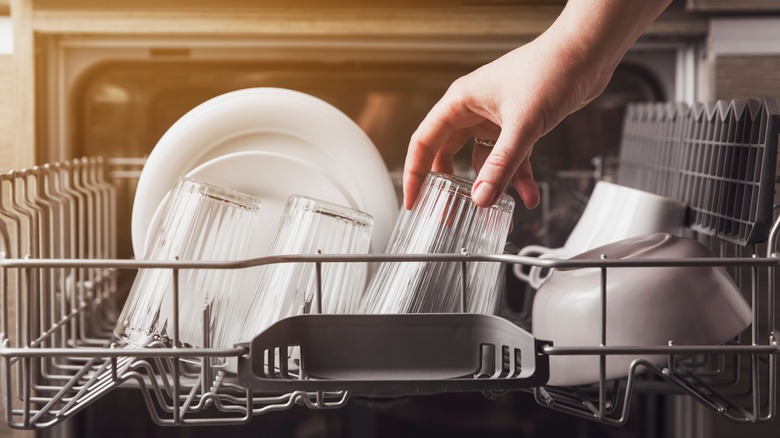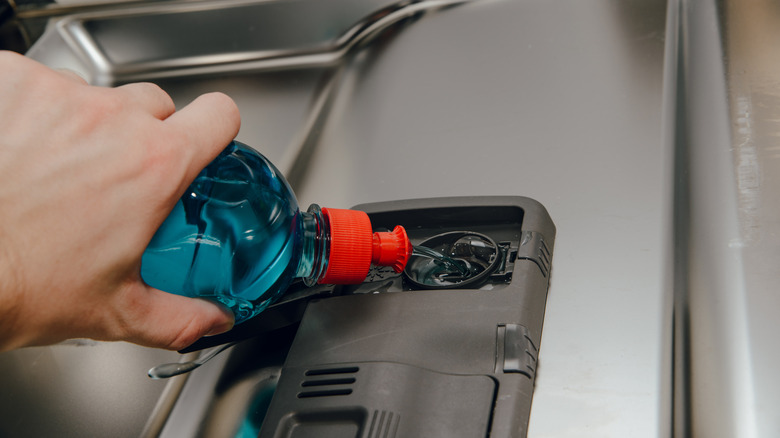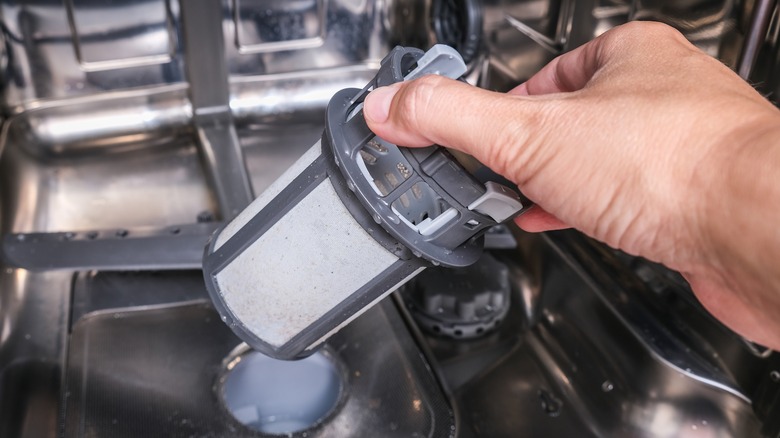Which Kitchenware Goes At The Bottom Of The Dishwasher?
There are all sorts of tricks for hand washing dishes, pots, and pans. Even orange-tinted food containers have an easy way to remove tomato stains by hand. For many of us, washing dishes is just a matter of tossing them into the dishwasher, adding detergent, and hitting the start button.
However, Fox 13 reports that of the 89 million households in the US with a dishwasher, 20% of them don't even use the dishwasher. The reasons for this are many. For small households, the number of dishes might be easy enough to do by hand. Some folks also enjoy the task of washing and drying by hand, so the dishwasher goes unutilized. Understandably, other people might be avoiding the energy costs it takes to run a large appliance.
Dish soap manufacturer, Cascade, is suggesting those 20% of dishwasher owners who don't use them "rethink the sink." If a dishwasher is less than 20 years old, it uses about four gallons of water per cycle. A running faucet only takes two minutes to dispense four gallons of water. So, you'd have to be pretty fast to save any water. As far as energy costs, Inspire Clean Energy estimates that an average one-hour cycle will cost 17 cents. As a result, a load per day adds up to about $1.19 per week in energy costs. For a larger household, that's probably a reasonable number.
How to load your dishwasher
The geography of a dishwasher is more complicated than you might think. However, if you follow a few simple rules, you'll get the best results from an efficient appliance. There's a best spot for everything in the dishwasher ... even a potato. For kitchenware, America's Test Kitchen lays out some ground rules that include placing delicate items on the top shelf, not overfilling the shelves, and making sure the spray arms can move freely.
This video from Whirlpool explains how larger items typically need to be placed on the bottom shelf. The dirty surfaces should always be pointed down or to the center. Otherwise, those surfaces won't be exposed to cleaning actions. Maybe the most important aspect of that video is how it highlights features of dishwashers most probably don't even realize exist. Lifewire reveals that only half of us read user manuals, and many of us probably threw them away when we first had the appliance installed.
Those manuals are almost always available on the manufacturer's website. Here's the Whirlpool site for downloading manuals. If you're struggling with the device, they're worth a look. In the case of this video, note the adjustable shelf heights to make room for larger items. Using the slotted flatware holders might be news to you. Manuals will also note that rinse aids are a very good idea. As Wirecutter explains, these additives, while not necessary, will ensure the best performance and cleanest dishes.
Let your dishwasher do the work
Pre-rinsing your dishes seems like a good idea, but it probably isn't necessary. In fact, it might be doing more harm to your cookware. According to Consumer Reports, modern machines sense how dirty the dishes are and adjust the wash cycle settings accordingly. Modern dish detergents utilize enzymes to eat away and dissolve the food residue, per CNET. Those enzymes need some food to do their job. Plus, you're using considerably more water than necessary.
Even a properly loaded dishwasher is only as good as it is clean. Refer to your manual for how often to clean your dishwasher. America's Test Kitchen suggests checking the filter once a week if you run the dishwasher every day. If not, a monthly check should be fine.
Finally, know what can and cannot go into your dishwasher. Today identifies a long list of kitchenware that shouldn't go into the dishwasher, no matter which shelf. Most importantly, please, above all else, you need to stop running your knives through the dishwasher.


